A Field Study of Work Type Influence on Air Traffic Controllers’ Fatigue Based on Data-Driven PERCLOS Detection
Abstract
:1. Introduction
2. Methods and Experiments
2.1. Methods
2.1.1. Selection of Fatigue Detection Method
2.1.2. Establishment of the PERCLOS Method for Fatigue Measurement
2.2. Experiments
2.2.1. Experimental Design
2.2.2. Participants
2.2.3. Fatigue Level Measurement
2.3. Data Analysis
3. Results and Discussion
3.1. Influence of Work Type on ATCOs’ Fatigue
3.2. Influence of Task Demand on ATCOs’ Fatigue by Work Type
3.3. Influence of Circadian Rhythm on ATCOs’ Fatigue by Work Type
3.4. Interaction between Task Demand and Circadian Rhythm and its Influence on ATCOs’ Fatigue by Work Type
4. Conclusions
Author Contributions
Funding
Institutional Review Board Statement
Informed Consent Statement
Acknowledgments
Conflicts of Interest
References
- International Civil Aviation Organization (ICAO). Doc. 9966, Manual for the Oversight of Fatigue Management Approaches, 2nd ed.; International Civil Aviation Organization: Montreal, QC, Canada, 2020. [Google Scholar]
- International Civil Aviation Organization (ICAO). Doc. 4444. (ICAO), Procedures for Air Navigation Services Air Traffic Management, 16th ed.; International Civil Aviation Organization: Montreal, QC, Canada, 2016. [Google Scholar]
- Sina Aviation. In Recent Years, Frequent Incidents of Controllers and Pilots Sleeping in the United States and the United Kingdom. 2014. Available online: http://sky.news.sina.com.cn/2014-08-19/105753195 (accessed on 15 October 2021).
- Southcentral Regional Administration of Civil Aviation Administration of China. Report the Investigation Report on the Air Traffic Controller Sleeping on Duty Causing CEA MU2528 Go Around; Plain Code Telegram form the Southcentral Regional Administration; No. 1289; Southwest Regional Administration of Civil Aviation Administration of China: Chengdu, China, 2014.
- Southwest Regional Administration of Civil Aviation Administration of China. Report on the Investigation and Handing of the Runway Incursion Incidence at the Tongren Fenghuang Airport in Oct. 10; Plain Code Telegram form the Southwest Regional Administration; No. 2096; Southwest Regional Administration of Civil Aviation Administration of China: Chengdu, China, 2017.
- Nealley, M.A.; Gawron, V.J. The effect of fatigue on air traffic controllers. Int. J. Aviat. Psychol. 2015, 25, 14–47. [Google Scholar] [CrossRef]
- Gawron, V.J.; Kaminski, M.A.; Serber, M.L.; Payton, G.M.; Hadjimichael, M.; Jarrott, W.M.; Estes, S.L.; Neal, T.A., II. Huamn Performance and Fatigue Research for Controllers—Revised; MTR100316R1; MITRE Technical Report; MITRE: Fairfax County, VA, USA, 2011. [Google Scholar]
- Wang, Y.; Zhang, Q.; Zhu, C.; Hu, M.; Duong, V. Human activity under high pressure: A case study on fluctuation scaling of air traffic controller’s communication behaviors. Phys. A Stat. Mech. Appl. 2016, 441, 151–157. [Google Scholar] [CrossRef]
- McCauley, D.; Nesthus, T. Status of FAA Traffic Control. Fatigue Interventions 2013–2016. In Proceedings of the 19th International Symposium on Aviation Psychology, Dayton, OH, USA, 8–11 May 2017. [Google Scholar]
- Chen, Z.; Xu, X.; Zhang, J.; Liu, Y.; Xu, X.; Li, L.; Wang, W.; Xu, H.; Jiang, W.; Wang, Y. Application of LC-MS-Based Global Metabolomic Profiling Methods to Human Mental Fatigue. Anal. Chem. 2016, 88, 11293–11296. [Google Scholar] [CrossRef] [PubMed] [Green Version]
- Chen, Z.; Zhang, J.; Ding, P. Fatigue Detection of Air Traffic Controllers Using Metabolomic Methods. In Proceedings of the 2019 IEEE 1st International Conference on Civil Aviation Safety and Information Technology (ICCASIT), Kunming, China, 17–19 October 2019; pp. 471–474. [Google Scholar]
- Zhang, J.; Yang, J.; Wu, C. From trees to forest: Relational complexity network and workload of air traffic controllers. Ergonomics 2015, 58, 1320–1336. [Google Scholar] [CrossRef] [PubMed]
- E, X.; Zhang, J. Holistic thinking and air traffic controllers’ decision making in conflict resolution. Trans. Res. Part. F Traffic Psychol. Behav. 2017, 45, 110–121. [Google Scholar]
- Chen, Z.; Zhang, J.; Zou, G.; Ding, P.; Li, S.; Gu, Y.; Chen, Y. Interaction effect of workload and circadian rhythm in air traffic controllers’ fatigue. In Proceedings of the 20th International Conference on Man-Machine-Environment System Engineering (ICMMESE), Zhengzhou, China, 20–21 December 2020; pp. 235–241. [Google Scholar]
- Li, W.; Kearney, P.; Zhang, J.; Hsu, Y.; Braithwaite, G. The analysis of occurrences associated with air traffic volume and air traffic controllers’ alertness for fatigue risk management. Risk Anal. 2021, 42, 1004–1018. [Google Scholar] [CrossRef] [PubMed]
- Dinges, D.; Grace, R. PERCLOS: A Valid Psychophysiological Measure of Alertness as Assessed by Psychomotor Vigilance; Tech. Rep. No. FHWA-MCRT-98-006; Federal Highway Administration: Washington, DC, USA, 1998.
- Wong, K.; Chan, A.H.S.; Ngan, S.C. The effect of long working hours and overtime on occupational health: A meta-analysis of evidence from 1998 to 2018. Int. J. Environ. Res. Public Health 2019, 16, 2102. [Google Scholar] [CrossRef] [PubMed] [Green Version]
- Bendak, S.; Rashid, H.S.J. Fatigue in aviation: A systematic review of the literature. Int. J. Ind. Ergon. 2020, 76, 102928. [Google Scholar] [CrossRef]
- Chan, A.H.S.; Ng, A.W.Y. Effects of display factors on Chinese proofreading performance and preferences. Ergonomics 2012, 55, 1316–1330. [Google Scholar] [CrossRef]
- Tsao, L.; Chang, J.; Ma, L. Fatigue of Chinese railway employees and its influential factors: Structural equation modelling. Appl. Ergon. 2017, 62, 131–141. [Google Scholar] [CrossRef] [PubMed]
- Chen, Z.; Zhang, J.; Ding, P.; Yang, X.; Peng, X.; Gu, Y. A scale to assess fatigue, concomitant mood and perception of air traffic controllers: A field study. In Proceedings of the IEEE 2nd International Conference on Civil Aviation Safety and Information Technology (ICCASIT), Weihai, China, 14–16 October 2020; pp. 874–877. [Google Scholar]
- Lin, J.H.; Kirlik, A.; Xu, X. New technologies in human factors and ergonomics research and practice. Appl. Ergon. 2018, 66, 179–181. [Google Scholar] [CrossRef] [PubMed]
- Sikander, G.; Anwar, S. Driver fatigue detection systems: A review. IEEE Trans. Intell. Transp. Syst. 2018, 20, 2339–2352. [Google Scholar] [CrossRef]
- Gu, Y.; Chen, Z.; Zhang, J.; Zou, G.; Ding, P.; Deng, W. A PERCLOS method for fine characterization of behaviour circadian rhythm. In Proceedings of the 20th International Conference on Man-Machine-Environment System Engineering (ICMMESE), Zhengzhou, China, 20–21 December 2020; pp. 243–249. [Google Scholar]
- Junaedi, S.; Akbar, H. Driver drowsiness detection based on face feature and PERCLOS. J. Phys. Conf. Ser. 2018, 1090, 012037. [Google Scholar] [CrossRef]
- Yue, S.; Pilon, P.; Cavadias, G. Power of the Mann-Kendall and Spearman’s rho tests for detecting monotonic trends in hydrological series. J. Hydrol. 2002, 259, 254–271. [Google Scholar] [CrossRef]
- Bishara, A.J.; Hittner, J.B. Testing the significance of a correlation with nonnormal data: Comparison of Pearson, Spearman, Transformation, and Resampling approaches. Psychol. Methods 2012, 17, 399–417. [Google Scholar] [CrossRef] [PubMed] [Green Version]
- Sun, Z.; Xu, Y.; Yan, Y.; Wang, T.; Liu, H.; Ma, J. Medical Statistics, 5th ed.; People’s sanitary publishing press: Beijing, China, 2020; pp. 55–73, 125–141, 151–153. [Google Scholar]
- Kearney, P.; Li, W.C.; Lin, J.J.H. The impact of alerting design on air traffic controllers’ response to conflict detection and resolution. Int. J. Ind. Ergon. 2016, 56, 51–58. [Google Scholar] [CrossRef]
- Straussberger, S.; Schaefer, D. Monotony in air traffic control. Air Traf. Con. Quart. 2007, 15, 183–207. [Google Scholar] [CrossRef]
- Yao, Y.; Zhao, X.; Du, H.; Zhang, Y.; Zhang, G.; Rong, J. Classification of fatigue and drunk driving based on decision tree methods: A simulator study. Int. J. Enveiron. Res. Public Health 2019, 16, 1935. [Google Scholar] [CrossRef] [PubMed] [Green Version]
- Xu, C.; Dong, D.; Ou, D.; Ma, C. Time-of-day control double-order optimization of traffic safety and data-driven intersections. Int. J. Enveiron. Res. Public Health 2019, 16, 870. [Google Scholar] [CrossRef] [PubMed] [Green Version]
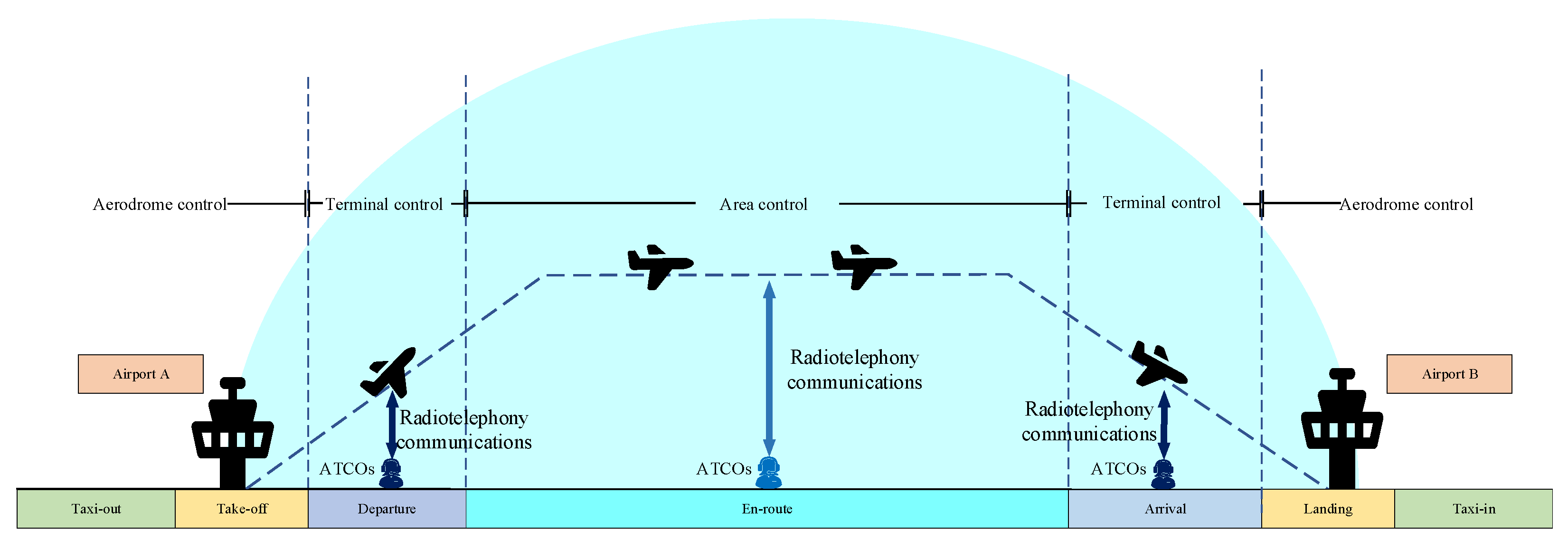

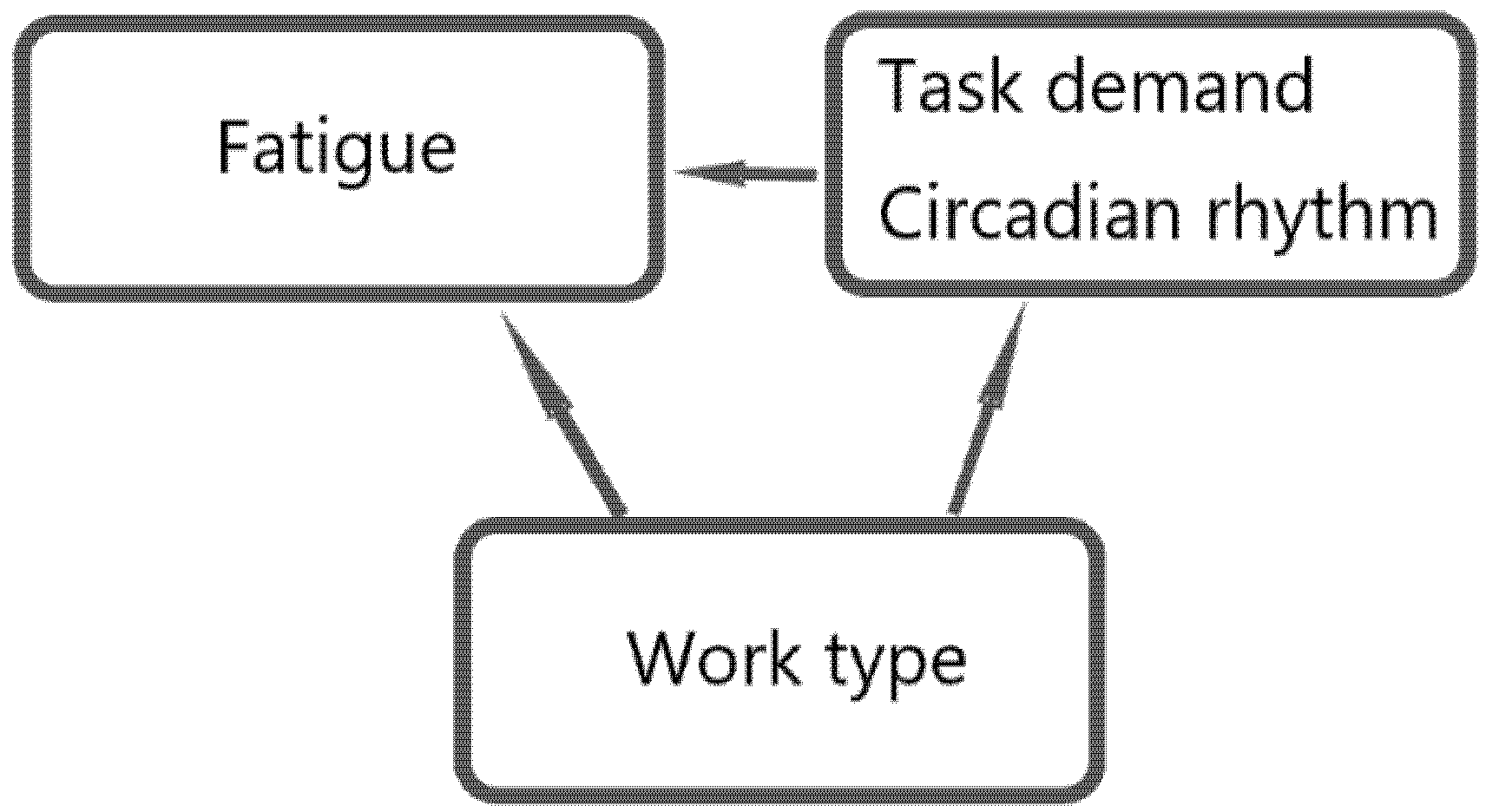
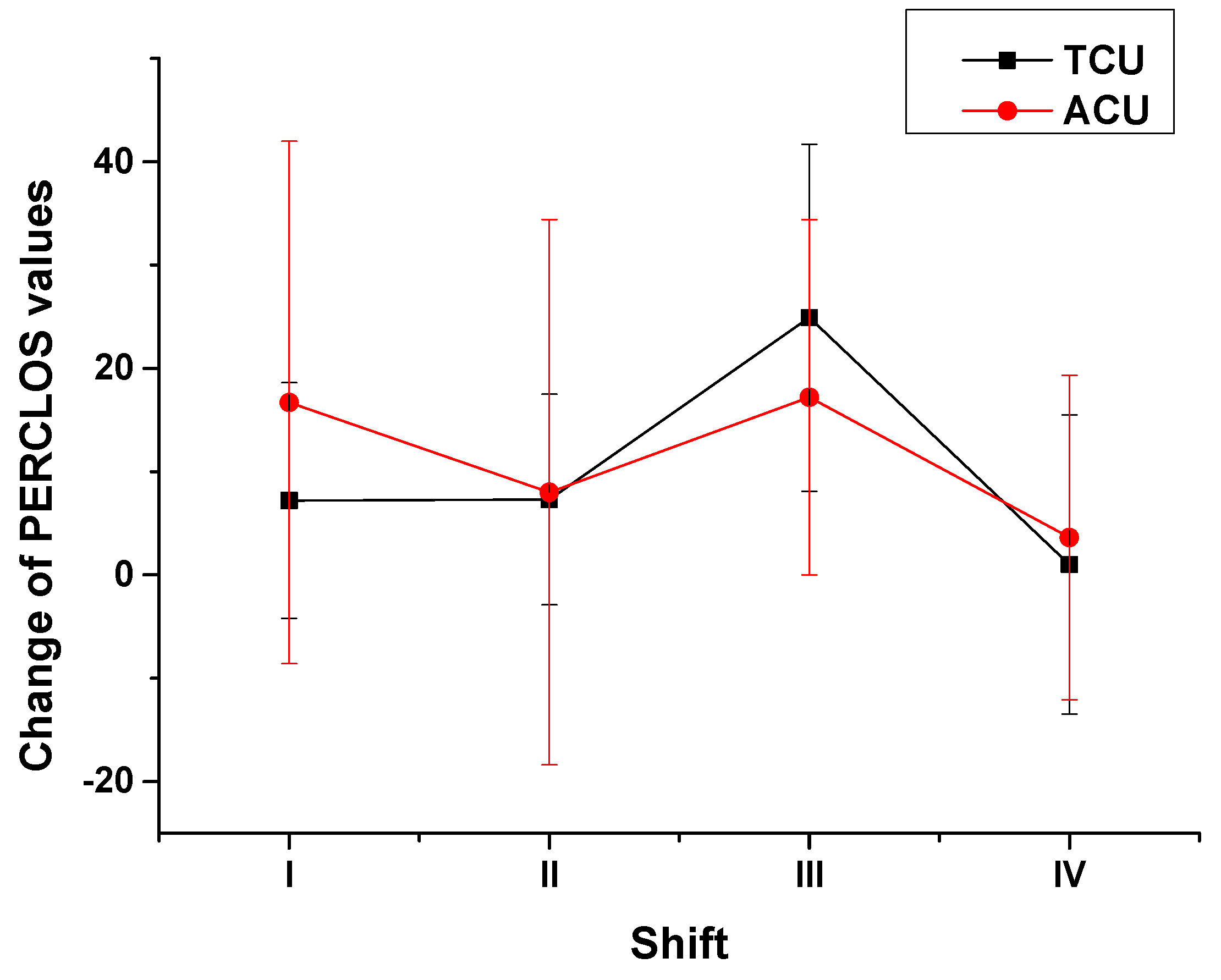
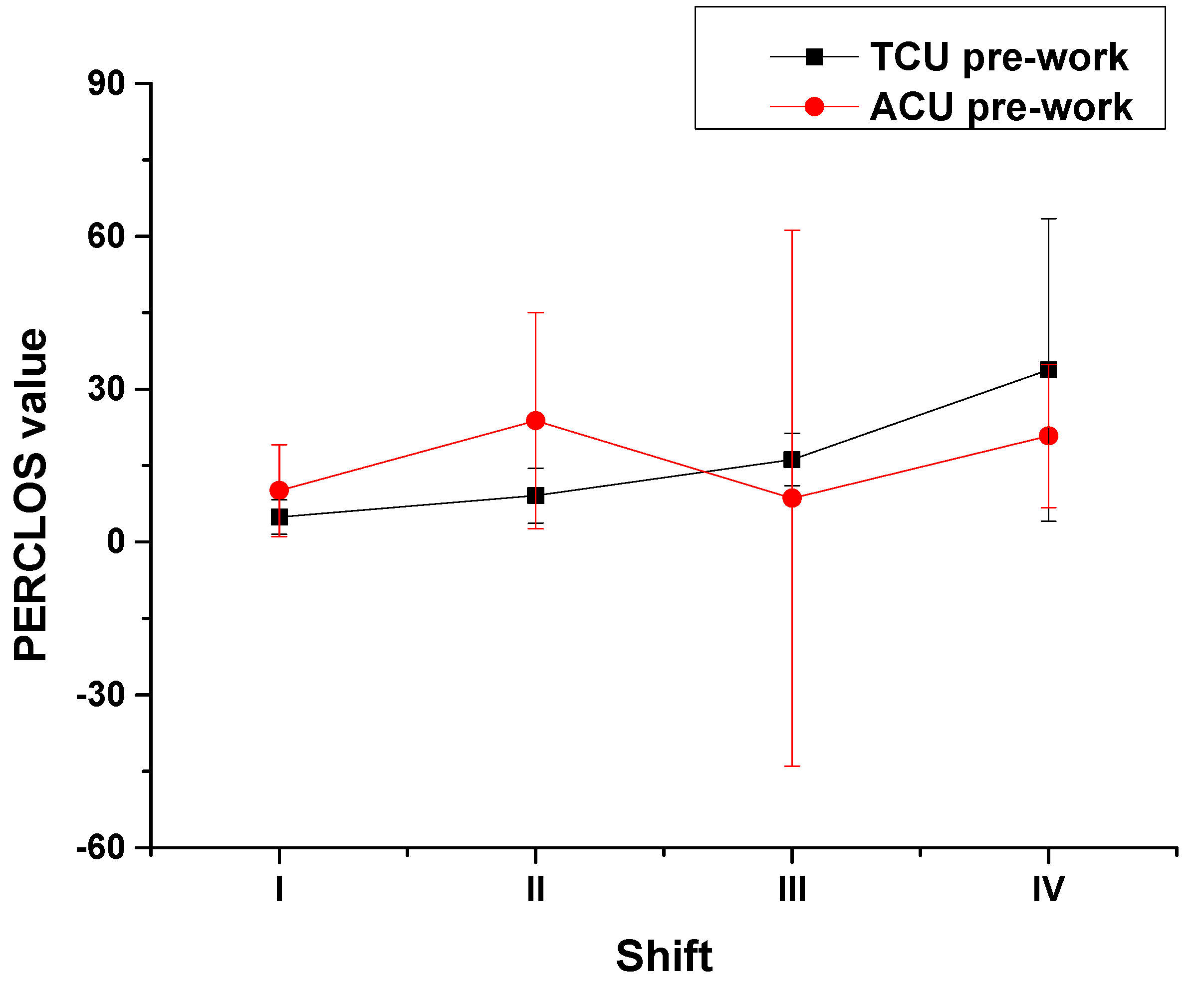
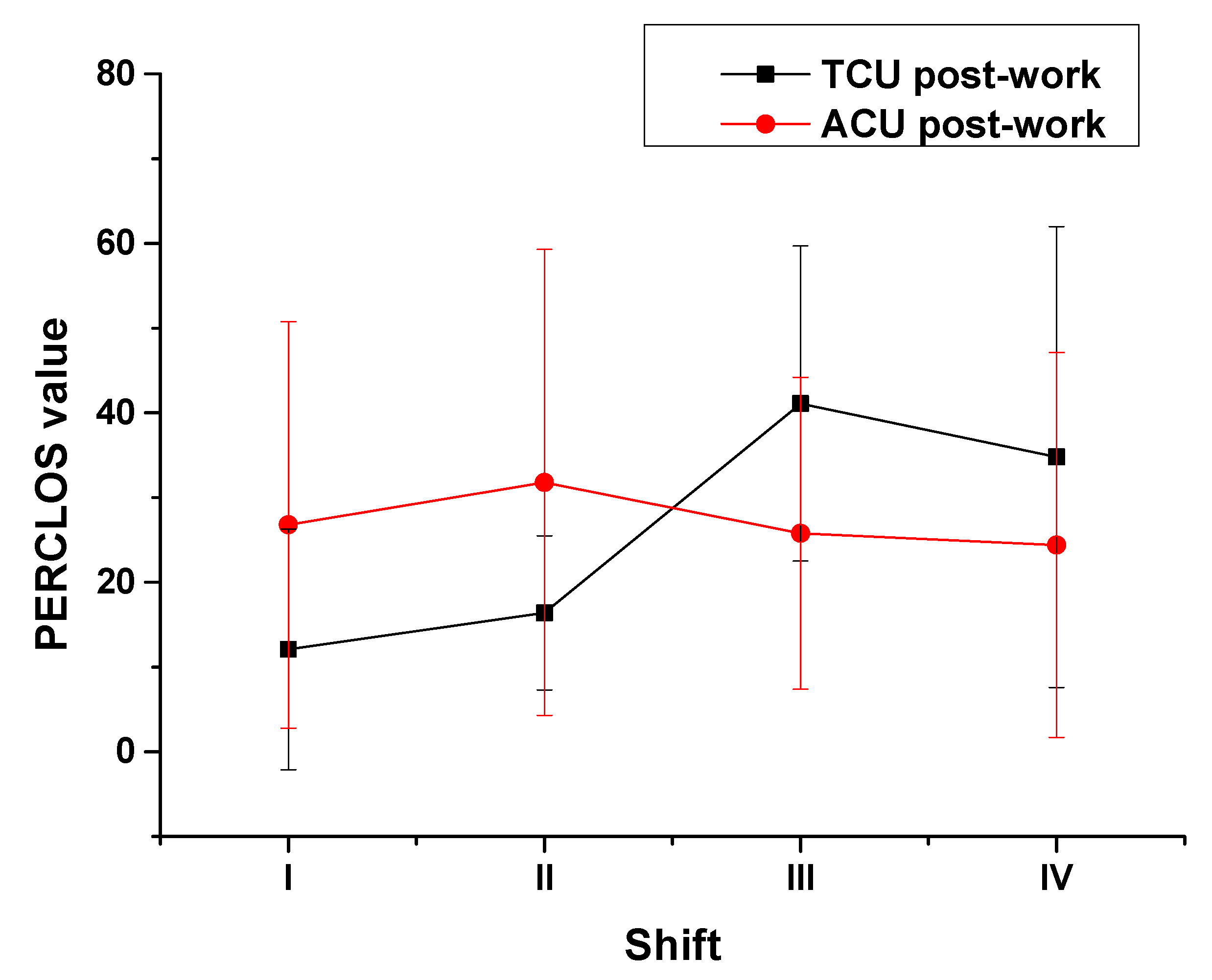
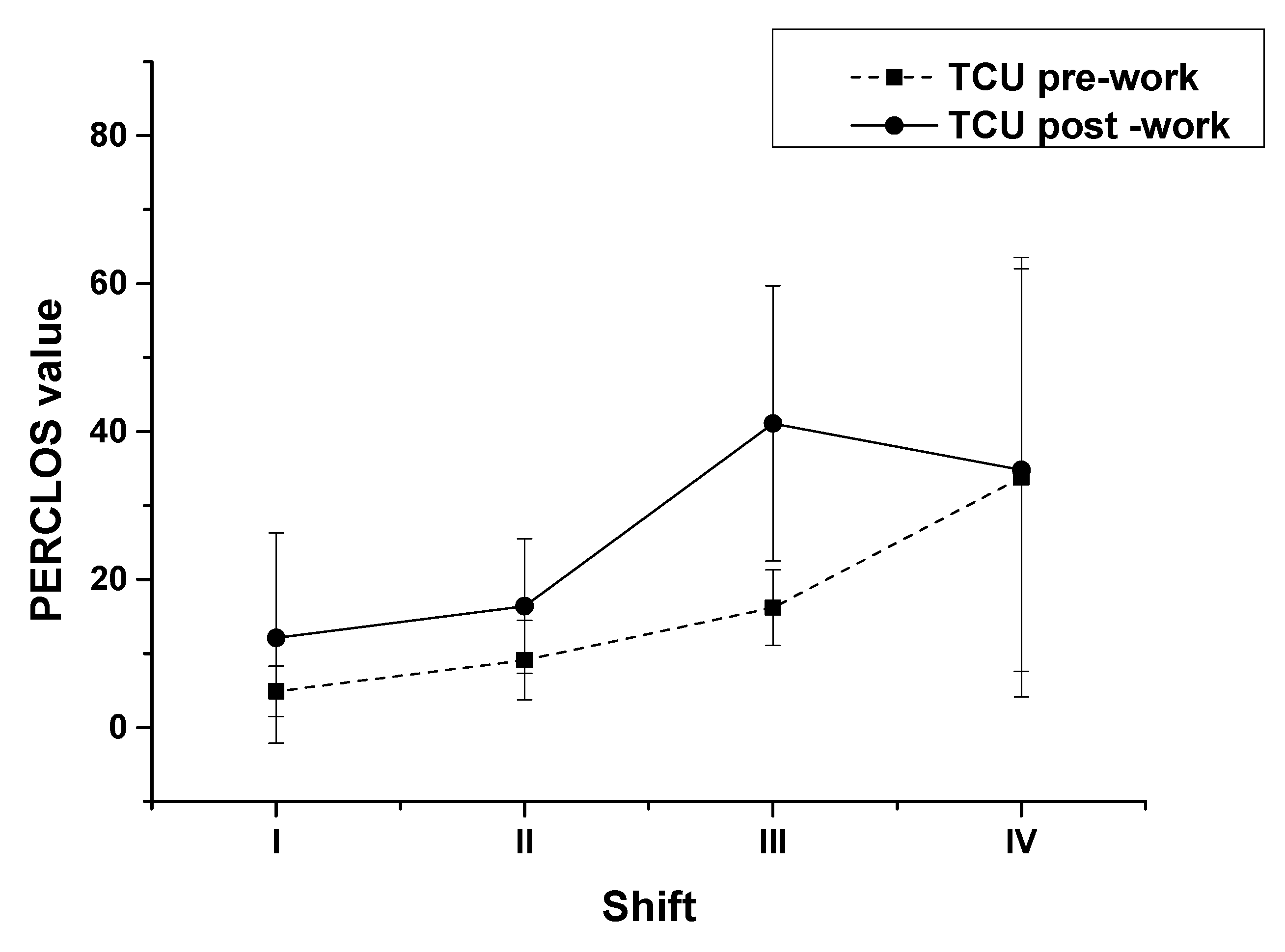

| Sample No. | Total Frames | Previous Method Detection Numbers | Previous Method Detection Rate | Current Method Detection Numbers | Current Method Detection Rate |
|---|---|---|---|---|---|
| 1 | 14,521 | 9494 | 65.38% | 13,494 | 92.93% |
| 2 | 14,521 | 11,062 | 76.18% | 12,577 | 86.61% |
| 3 | 14,521 | 10,102 | 69.57% | 14,250 | 98.13% |
| 4 | 14,521 | 8953 | 61.66% | 13,053 | 89.89% |
| 5 | 14,521 | 9903 | 68.20% | 13,344 | 91.89% |
| average | 14,521 | 9494 | 65.38% | 13,494 | 92.93% |
| Name | Speed of Image Collection | Frame | Date Bit Rate | Frame Width | Frame Height |
|---|---|---|---|---|---|
| Value | 24/second | 24 FPS/second | 14 Mbps/second | 640 pixel | 480 pixel |
| Factors | Levels | |||
|---|---|---|---|---|
| Work type | TCU | ACU | ||
| Task demand | Pre-shift | Post-shift | ||
| Circadian rhythm | Shift I | Shift II | Shift III | Shift IV |
| Work Type | Age | Gender | People Number | Shift I | Shift II | Shift III | Shift IV |
|---|---|---|---|---|---|---|---|
| TCU | 23–36 Mean 29 | Male | 32 | 7 | 14 | 7 | 4 |
| ACU | 23–38 Mean 29 | Male | 35 | 7 | 9 | 14 | 5 |
| Total | -- | -- | 67 | 14 | 23 | 21 | 11 |
| Factors | PERCLOS Value Index | Data Analysis Methods |
|---|---|---|
| Work type | change, pre-shift, and post-shift | Spearman correlation test |
| Task demand | change | Wilcoxon matched-pairs test |
| Circadian rhythm | pre-shift | Repeated measures analysis of variance (ANOVA), One-way ANOVA, and multiple comparison analysis |
| Interaction between circadian rhythm and task demand | pre- and post-shift | Multiple-factor repeated measures ANOVA |
| Statistical Method | TCU | ACU |
|---|---|---|
| Wilcoxon matched-pairs test | Z = −3.60, p < 0.001 | Z = −3.09, p = 0.002 |
| Task Demand | Shift I | Shift II | Shift III | Shift IV | |||||
|---|---|---|---|---|---|---|---|---|---|
| TCU | ACU | TCU | ACU | TCU | ACU | TCU | ACU | ||
| Flight volume | arrival | 10 | 10 | 26 | 26 | 28 | 28 | 8 | 8 |
| departure | 40 | 40 | 26 | 26 | 22 | 22 | 12 | 12 | |
| overflight | 5 | 164 | 6 | 143 | 5 | 126 | 1 | 28 | |
| Monitoring time (min) | 10.0 | 23.0 | 10.8 | 22.8 | 11.6 | 21.1 | 12.3 | 20.7 | |
| Heading change | 2.2 | 2.2 | 2.5 | 2.0 | 2.3 | 1.7 | 1.9 | 1.4 | |
| Speed change | 1.2 | 0.5 | 1.0 | 0.5 | 1.0 | 0.5 | 1.1 | 0.4 | |
| Altitude change | 1.1 | 1.5 | 1.0 | 1.4 | 1.2 | 1.3 | 0.8 | 1.1 | |
| Change PERCLOS value | 7.2 | 16.7 | 7.3 | 8 | 24.9 | 17.2 | 1 | 3.6 | |
| Statistical Method | TCU | ACU |
|---|---|---|
| Repeated measures ANOVA | Among the shifts **, F (3, 28) = 7.07, p = 0.001 | Among the shifts, F (3, 31) = 0.99, p = 0.408 |
| One-way ANOVA | Pre-shift **, F (3, 31) = 7.071, p = 0.001 Post-shift **, F (3, 31) = 6.049, p = 0.003 | Pre-shift *, F (3, 34) = 3.145, p = 0.039 Post-shift, F (3, 34) = 0.165, p = 0.919 |
| Multiple comparison analysis using repeated measures | Shift I vs. shift III **, p = 0.003; vs. shift IV **, p = 0.001 Shift II vs. shift III **, p = 0.006; vs. shift IV **, p = 0.003 Shift I vs. shift II, p = 0.431 Shift III vs. shift IV, p = 0.447 | No significant difference by shift was observed. |
| Multiple comparison analysis for pre-shift values | Shift IV vs. shift I **, p < 0.001; vs. shift II **, p = 0.001; vs. shift III *, p = 0.015 No significant difference observed between shift I, II, III. | Shift II vs. shift I *, p = 0.046; vs. shift III *, p = 0.010; No significant difference was observed between shifts I, III, and IV. |
| Multiple comparison analysis for post-shift values | Shift I vs. shift III **, p = 0.001; vs. shift IV *, p = 0.026 Shift II vs. shift III **, p = 0.002; vs. shift IV *, p = 0.044 Shift I vs. shift II, p = 0.546 Shift III vs. shift IV, p = 0.516 | No significant difference between the shifts was observed. |
| Statistical Method | TCU | ACU |
|---|---|---|
| Multiple-factor repeated measures ANOVA | F (3, 28) = 4.13; p = 0.015 | F (3,31) = 0.72, p = 0.546 |
Publisher’s Note: MDPI stays neutral with regard to jurisdictional claims in published maps and institutional affiliations. |
© 2021 by the authors. Licensee MDPI, Basel, Switzerland. This article is an open access article distributed under the terms and conditions of the Creative Commons Attribution (CC BY) license (https://creativecommons.org/licenses/by/4.0/).
Share and Cite
Zhang, J.; Chen, Z.; Liu, W.; Ding, P.; Wu, Q. A Field Study of Work Type Influence on Air Traffic Controllers’ Fatigue Based on Data-Driven PERCLOS Detection. Int. J. Environ. Res. Public Health 2021, 18, 11937. https://doi.org/10.3390/ijerph182211937
Zhang J, Chen Z, Liu W, Ding P, Wu Q. A Field Study of Work Type Influence on Air Traffic Controllers’ Fatigue Based on Data-Driven PERCLOS Detection. International Journal of Environmental Research and Public Health. 2021; 18(22):11937. https://doi.org/10.3390/ijerph182211937
Chicago/Turabian StyleZhang, Jianping, Zhenling Chen, Weidong Liu, Pengxin Ding, and Qinggang Wu. 2021. "A Field Study of Work Type Influence on Air Traffic Controllers’ Fatigue Based on Data-Driven PERCLOS Detection" International Journal of Environmental Research and Public Health 18, no. 22: 11937. https://doi.org/10.3390/ijerph182211937
APA StyleZhang, J., Chen, Z., Liu, W., Ding, P., & Wu, Q. (2021). A Field Study of Work Type Influence on Air Traffic Controllers’ Fatigue Based on Data-Driven PERCLOS Detection. International Journal of Environmental Research and Public Health, 18(22), 11937. https://doi.org/10.3390/ijerph182211937





